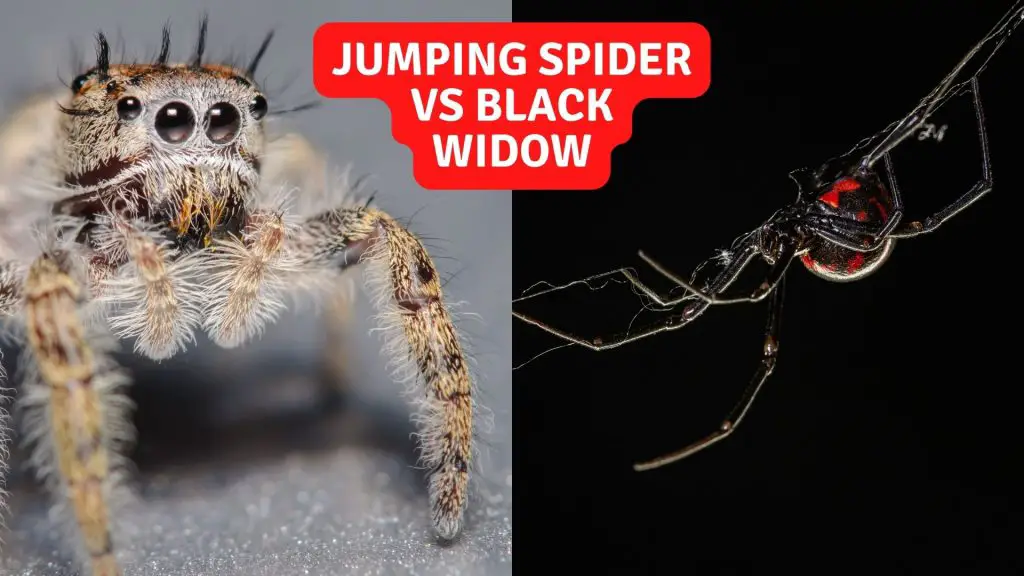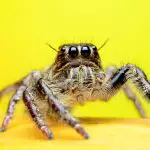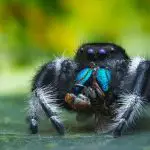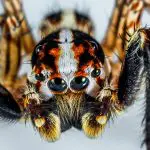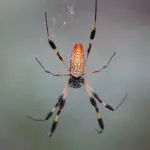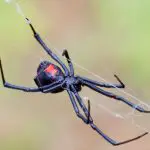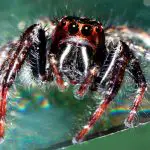Last updated on February 1st, 2023 at 09:52 am
When looking at a Jumping Spider vs. Black Widow, you’ll notice significant differences between them. Let’s learn a little more about these tiny predators…
Due to their small, black bodies, jumping spiders are frequently mistaken for black widow spiders. Jumping spiders can also be a light shade of brown, tan, or gray with faint white, yellow, red, blue, or green markings. However, there are several distinguishing factors, including their size; an adult jumping spider can be about 4 to 18mm whereas Black Widows can reach 38mm.
Jumping spider vs. brown recluse
The dark brown or light tan Brown Recluse spider, commonly known as the brown spider or fiddleback spider, is a soft-bodied, solitary species. The adult spider has long, delicate legs coated in small, dark hairs, about half an inch in length.
It has three pairs of eyes in a semicircle on the forepart of the head, a violin-shaped dark marking directly behind the eyes, and the violin’s neck pointing towards the bulbous abdomen. These distinctively long legs distinguish it from other spiders, such as the jumping spider.
On the contrary, jumping spiders come in various colors, shapes, and sizes. Unlike the Brown Recluse, they have eight eyes, one large pair at the forefront. Moreover, while a Brown Recluse is an active night hunter, the jumping spider hunts for its food during the day since it has perfect eyesight.
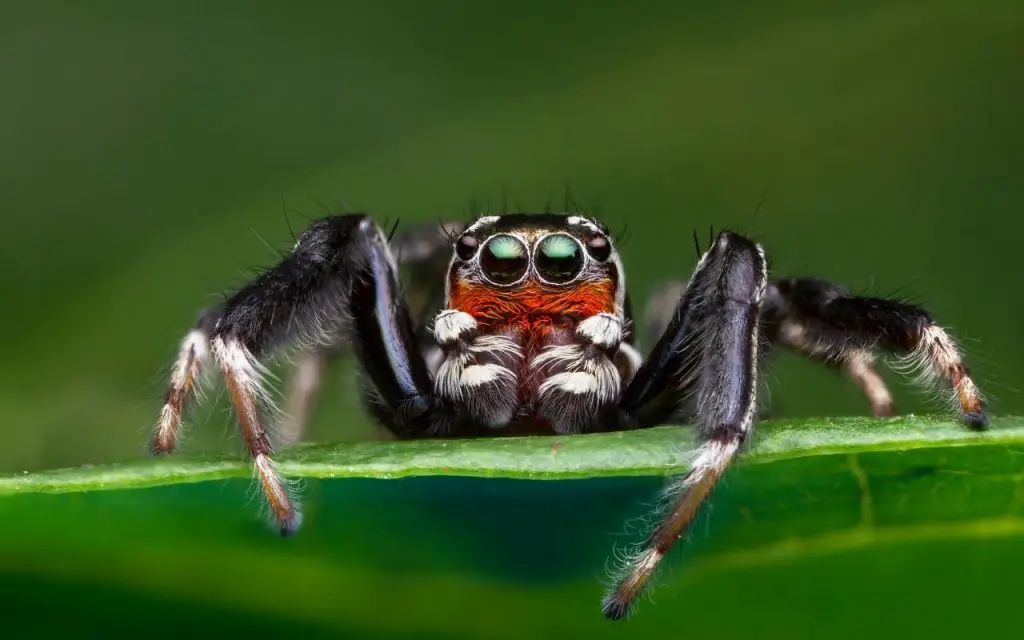
Will Jumping Spiders Eat Black Widows?
A Jumping spider can feed on the black widow, a venomous spider that all other spiders fear. Like other prey, a jumper spots and stalks a Black widow before the first attack. It then puts a webbing line before jumping onto the target prey. It injects venom into the black widow before eating it.
Are Jumping Spiders Friendly?
Jumping spiders like the common Regal Jumper are not only harmless but also friendly to human beings. Despite being carnivorous, they do not prey on people or pets. In an open field outdoors, they can jump on you but not hurt you, though they appear scary. Children love to play with them due to their bold and attractive colors.
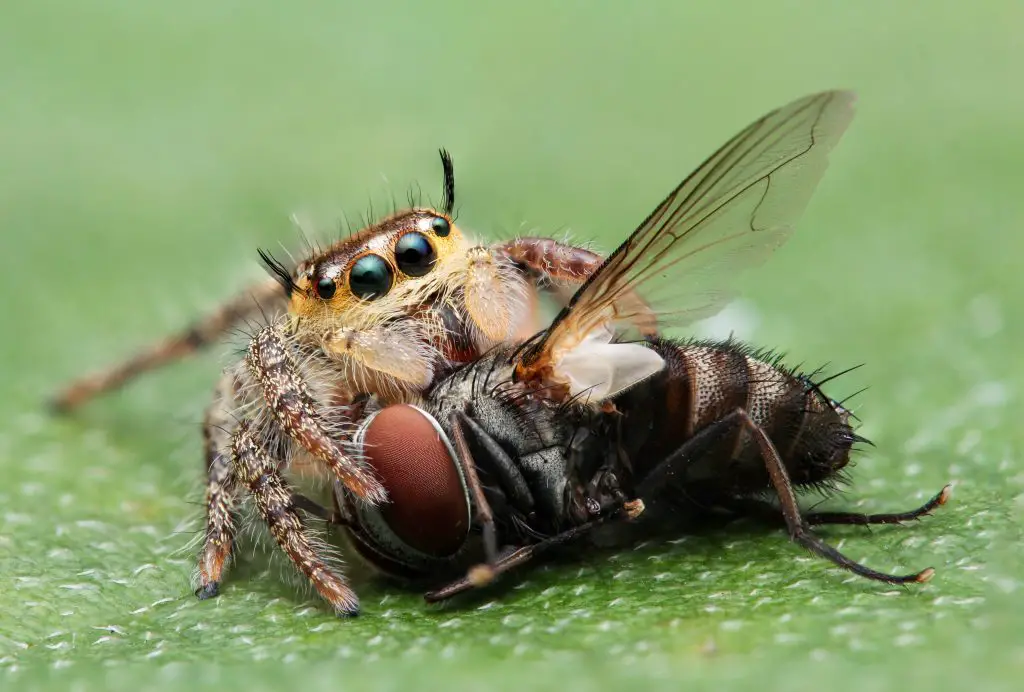
Are Jumping Spiders the Smartest Spider?
The Fringed Jumping Spider (Portia fimbriata), a species of jumping spiders, is the world’s known smartest spider. Commonly known as Portia, it not only preys on animals more significant than itself but also plans on how to get them.
It is specialized in hunting and only preys on other spiders. It has extremely dense hair growth on its body, which gives it an “unspider-like” appearance. It is also unusually well-camouflaged. In fact, it somewhat resembles a piece of trash, and it uses this to its advantage.
While hunting, Portia follows other spiders, typically ones that spin orb webs. The exciting thing about this species is how it approaches and engages in combat with its prey using a variety of tactics. Amazingly, if one approach fails, it will switch to another one immediately. It takes advantage of its excellent eyesight, like all jumping spiders.
When it spots its prey, another spider, it approaches it carefully, assessing the best method of attack; it applies different tricks on different species. One common tactic of Portia is moving near the web’s edge and slowly plucking it with its legs.
The vibrations lure the prey closer. Portia keeps changing the type of vibrations until it succeeds. However, should the prey sense the predator’s presence, Portia will back off and return later.
Tiny Black Jumping Spider
Phidippus audax is a tiny black jumping spider of the genus phidippus. It has large eyes that set it apart from other jumping spiders. Additionally, it is all black with a distinctive white triangle in its abdomen. Like other jumping spiders, it has a stereoscopic vision for visual communication and stalk prey.
Also called a bold jumping spider is a solitary carnivore that uses its eyesight to hunt its prey. It feeds on insects and terrestrial arthropods like dragonflies, caterpillars, grasshoppers, and other spiders. Unlike most spiders, Phidippus audax does not require webs to catch prey.
These unique spiders primarily live in temperate climates and many terrestrial habitats such as grasslands, agricultural fields, and open woodlands. While it is rare for them to bite, they will bite in defense under threat.
Can Black Jumping Spiders Hurt You?
A black jumping spider is generally harmless to human beings. It is one of the closest spiders to human habitats but does not target humans. However, it can attack if it feels threatened.
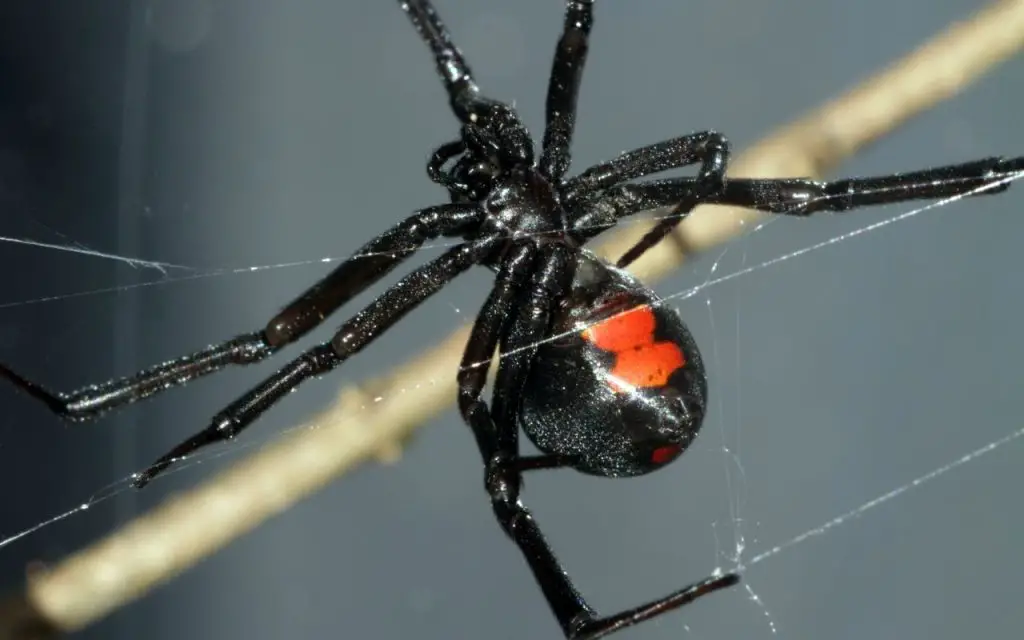
Are Jumping Spiders Poisonous?
Although jumping spiders have fangs and produce venom, their venom is not a significant medical threat. They are non-poisonous and are not considered a threat to humans.
Is There a Spider That Looks like a Black Widow but Isn’t?
The false widow spider (Steatoda spp.) looks almost like a black widow spider, but the two are different. Besides the varying markings, false widow spiders have a thin white or lighter band around the front of their abdomen toward their heads. These markings, particularly in adult females, might be varied, fading, or absent and differ according to species.
It differs from a typical black widow spider in that it has a glossy chocolate brown color and lacks the hourglass marking of the black widow. In addition, it is a bit smaller than the actual black widow. However, the two share the rounded abdomen trait.
Still, unlike black widow, false widow spider does not bite unless disturbed. Moreover, it is not as poisonous as the latter.
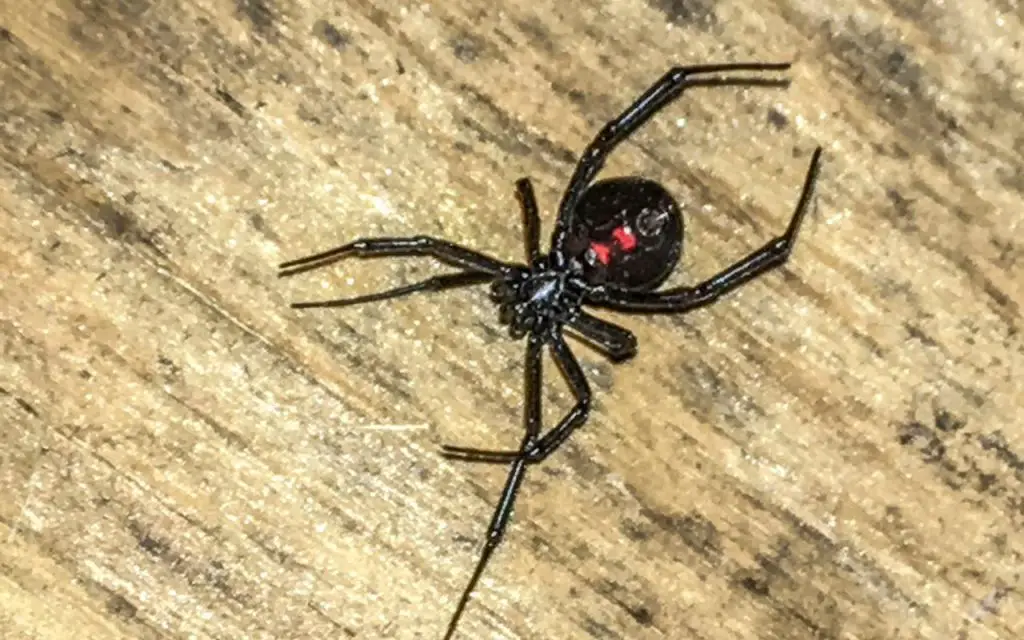
Can Black Widows Jump?
A black widow spider cannot jump. However, it can easily move up walls and across ceilings, which is one of the reasons they can be so difficult to eradicate. Even if you believe your home is spider-free, a black widow may still be hiding someplace. Its feet have a firm grip that keeps them from falling off the wall.
Furthermore, it can move so fast if trying to escape danger and can be dangerous at this point. Therefore, using your hands to remove black widows from your home is not advisable. If you have an invasion, consider calling a professional.
How Do You Tell if a Spider is a False Widow?
You can identify a false black widow from its size, shape, and color. Male abdomens are smaller and less rounded but are more distinctly defined than female abdomens, which are globular and glossy. The largest species, the noble false widow, is about 10 to 14mm in length and features distinctive markings resembling a skull on its abdomen.
However, these markings vary; sometimes, they may be non-existent, especially in mature females. In addition, a false widow has a slightly lighter or narrow white band towards its head.
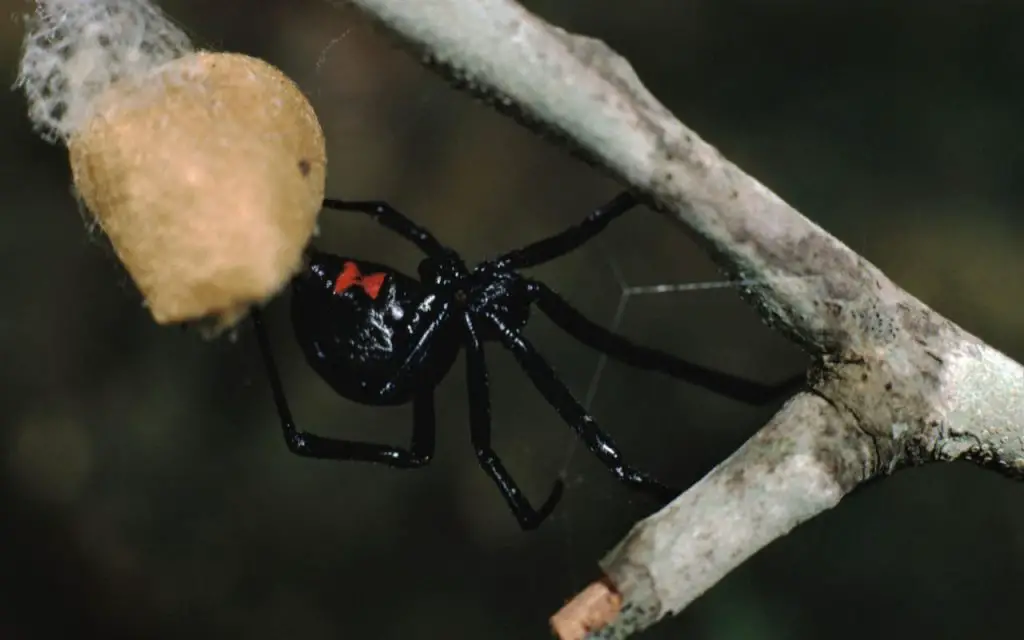
Bold Jumping Spider Bite
The bold jumper spider is a tiny black and hairy spider that rarely bites. They are shy and often retreat if you approach them, yet they are the most common around homes. However, if you disturb them, they can bite as a self-defense mechanism. The following are some symptoms of a bold jumper bite:
- Minor pain
- Itching
- Swelling in the affected area
- Redness that may persist for up to two days
If you have a bold jumper bite, it will help to wash the area with clean water and soap. Afterward, suppress any swelling with ice.
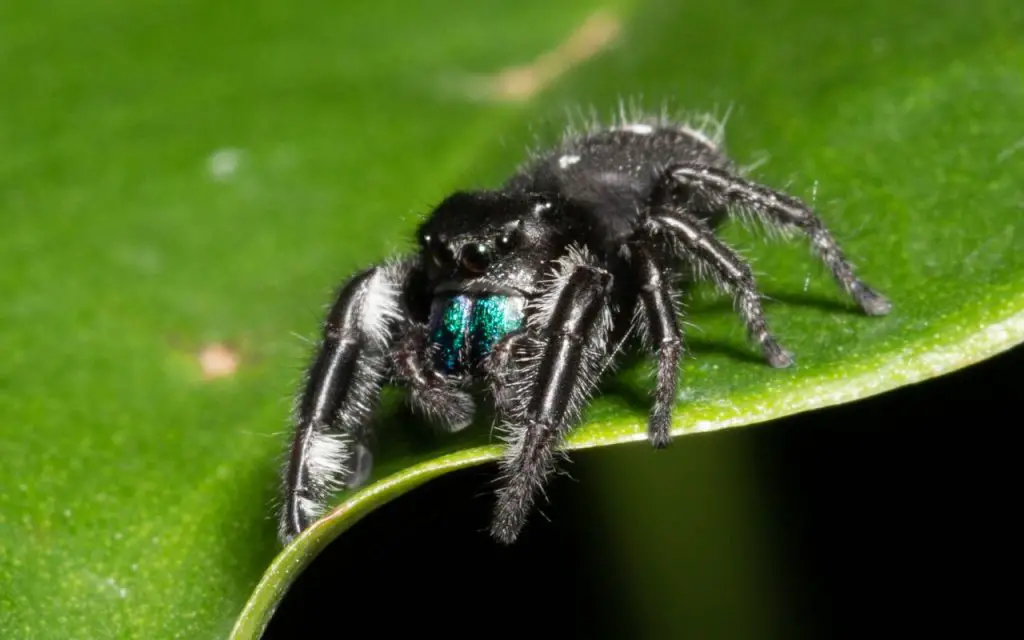
Jumping Spider Attack
A jumping spider may never attack you unless you threaten its life. However, it may not show symptoms except for a tiny mosquito-bite-sized welt if you get a bite. Medical experts consider this bite less severe than a bee sting.
The best news is that you can treat a jumping spider bite at home with the following procedure:
- Use clean water and soap to wash the area. It helps prevent bacteria from invading your skin barrier and later causing infections.
- If it causes a burning sensation, calm it with a cold compress such as a wet cloth. Cold compress also helps with redness and discoloration symptoms
- If a welt appears, it would be best to apply a topical antibiotic ointment
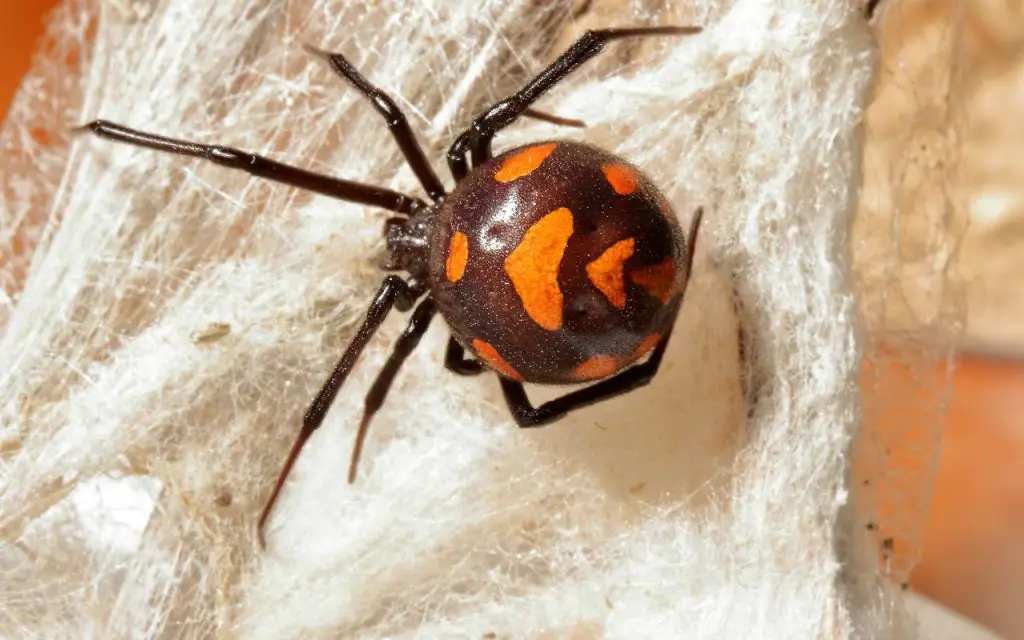
FAQ Relating to Jumping Spider vs. Black Widow
The following are some of the frequently asked questions about jumping spider vs black widow:
What Happens if a Black Widow Bites You?
You may have excruciating swelling in the area of the black widow spider bite. Additionally, you can get stomachaches, cramps, and muscle spasms. These symptoms may worsen for up to twelve hours before they start subsiding. Moreover, a black widow bite to a child or an infant can be worse than an adult. Consult a doctor or emergency services immediately.
What Kills Black Widows Instantly?
While there are several DIY ways to eliminate black widow spiders, direct-contact insecticide sprays can do the task almost instantly. However, it is advisable to keep a safe distance and ensure that there are no other occupants while using these harmful chemicals.
Can You be saved from a Black Widow Bite?
A black widow spider bite rarely kills, but it is advisable to seek medical attention when it happens because it can make you sick. If there is evidence of a severe envenomation, the doctor will apply antivenin to neutralize the venom.
Which Spider Kills the Most Humans?
Sydney funnel-web spider is the deadliest known spider in the world. Experts say that its venom is capable of causing the flesh to rot – a phenomenon known as necrosis.
Distinguishing a jumping spider from a black widow spider is straightforward. However, note the following critical facts:
- A black widow is more poisonous than a jumping spider
- A jumping spider does not bite, except under provocation
- A false widow is different from a black widow and also less poisonous
- A black widow bite can get worse if you have underlying health issues

